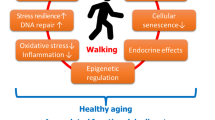Abstract
Background and aims: Low physical activity, one of five criteria in a validated clinical phenotype of frailty, is assessed by a standardized, semiquantitative questionnaire on up to 20 leisure time activities. Because of the time demanded to collect the interview data, it has been challenging to translate to studies other than the Cardiovascular Health Study (CHS), for which it was developed. Considering subsets of activities, we identified and evaluated streamlined surrogate assessment methods and compared them to one implemented in the Women’s Health and Aging Study (WHAS). Methods: Using data on men and women ages 65 and older from the CHS, we applied logistic regression models to rank activities by “relative influence” in predicting low physical activity.We considered subsets of the most influential activities as inputs to potential surrogate models (logistic regressions). We evaluated predictive accuracy and predictive validity using the area under receiver operating characteristic curves and assessed criterion validity using proportional hazards models relating frailty status (defined using the surrogate) to mortality. Results: Walking for exercise and moderately strenuous household chores were highly influential for both genders. Women required fewer activities than men for accurate classification. The WHAS model (8 CHS activities) was an effective surrogate, but a surrogate using 6 activities (walking, chores, gardening, general exercise, mowing and golfing) was also highly predictive. Conclusions: We recommend a 6 activity questionnaire to assess physical activity for men and women. If efficiency is essential and the study involves only women, fewer activities can be included.
Similar content being viewed by others
References
Fried LP, Tangen CM, Walston J et al. Frailty in older adults: evidence for a phenotype. J Gerontol Med Sci 2001; 56A: M146–56.
Bandeen-Roche K, Xue QL, Ferrucci L et al. Phenotype of frailty: characterization in the Women’s Health and Aging Studies. J Gerontol Med Sci 2006; 61: 262–6.
Taylor HL, Jacobs DR, Schucker B, Knudsen J, Leon AS, Debacker G. A questionnaire for the assessment of leisure-time physical activities. J Chronic Dis 1978; 31: 745–55.
Mohr BA, Bhasin S, Kupelian V, Araujo AB, O’Donnell AB, McKinlay JB. Testosterone, sex hormone binding globulin, and frailty in older men. J Am Geriatr Soc 2007; 55: 548–55.
Purser JL, Kuchibhatla MN, Fillenbaum GG, Harding T, Peterson ED, Alexander KP. Identifying frailty in hospitalized older adults with significant coronary artery disease. J Am Geriatr Soc 2006; 54: 1674–81.
Gill TM, Gahbauer EA, Allore HG, Han L. Transitions between frailty states among community-living older persons. Arch Intern Med 2006; 166: 418–23.
Faber MJ, Bosscher RJ, Chin A Paw MJ, Wieringen PC. Effects of exercise programs on falls and mobility in frail and pre-frail older adults: a multicenter randomized controlled trial. Arch Phys Med Rehabil 2006; 87: 885–96.
Bartali B, Frongillo EA, Bandinelli S et al. Low nutrient intake is an essential component of frailty in older persons. J Gerontol A Biol Sci Med Sci 2006; 61: 589–93.
Woods NF, LaCroix AZ, Gray SL et al. Frailty: emergence and consequences in women aged 65 and older in the Women’s Health Initiative Observational Study. J Am Geriatr Soc 2005; 53: 1321–30.
Puts MT, Lips P, Deeg DJ. Sex differences in the risk of frailty for mortality independent of disability and chronic diseases. J Am Geriatr Soc 2005; 53: 40–7.
Ottenbacher KJ, Ostir GV, Peek M, Snih SA, Raji MA, Markides KS. Frailty in older Mexican Americans. J Am Geriatr Soc 2005; 53: 1524–31.
Ostir GV, Ottenbacher KJ, Markides KS. Onset of frailty in older adults and the protective role of positive affect. Psychol Aging 2004; 19: 402–8.
Fried LP, Borhani NO, Enright P et al. The Cardiovascular Health Study: design and rationale. Ann Epidemiol 1991; 3: 263–76.
Tell GS, Fried LP, Hermason B et al. Recruitment of adults 65 years and older as participants in the Cardiovascular Health Study. Ann Epidemiol 1993; 5: 358–66.
Ainsworth BE, Haskell WL, Leon AS et al. Compendium of physical activities: classification of energy costs of human physical activities. Med Sci Sports Exerc 1993; 25: 71–80.
Ainsworth BE, Haskell WL, Whitt MC et al. Compendium of physical activities: an update of activity codes and MET intensities. Med Sci Sports Exerc 2000; 32: S498–516.
van Stralen KJ, Doggen CJ, Lumley T et al. The relationship between exercise and risk of venous thrombosis in elderly people. J Am Geriatr Soc 2008; 56: 517–22.
McCullagh P, Nelder JA. Generalized linear models. Chapman & Hall/CRC, 1989.
Hanley JA, McNeil BJ. The meaning and use of the area under a receiver operating characteristic (ROC) curve. Radiology 1982; 143: 29–36.
Harrell FE. Regression modeling strategies: with applications to linear models, logistic regression, and survival analysis. Springer Verlag, 2001.
Fried LP, Kronmal RA, Newman AB et al. Risk factors for 5-year mortality in older adults: the Cardiovascular Health Study. JAMA 1998; 279: 585–92.
Akaike H. A new look at the statistical model identification. IEEE Trans Automat Contr 1974; 19: 716–23.
Eckel SP. Quantifying individual and city level modification of the health effects of air pollution in older adults. PhD Thesis. Johns Hopkins University, 2009.
Sallis JF, Haskell WL, Wood PD et al. Physical activity assessment methodology in the five-city project. Am J Epidemiol 1985; 121: 91–106.
Ware Jr JE, Sherbourne CD. The MOS 36-item short-form health survey (SF-36). Med Care 1992; 30: 473–83.
Washburn RA, Smith KW, Jette AM, Janney CA. The physical activity scale for the elderly (PASE): development and evaluation. J Clin Epidemiol 1993; 46: 153–62.
Stel VS, Smit JH, Pluijm SMF, Visser M, Deeg DJH, Lips P. Comparison of the LASA Physical Activity Questionnaire with a 7-day diary and pedometer. J Clin Epidemiol 2004; 57: 252–8.
Anderson GL, Manson J, Wallace R et al. Implementation of the Women’s Health Initiative study design. Ann Epidemiol 2003; 13: 5–17.
Author information
Authors and Affiliations
Corresponding author
Rights and permissions
About this article
Cite this article
Eckel, S.P., Bandeen-Roche, K., Chaves, P.H.M. et al. Surrogate screening models for the low physical activity criterion of frailty. Aging Clin Exp Res 23, 209–216 (2011). https://doi.org/10.1007/BF03324962
Received:
Accepted:
Published:
Issue Date:
DOI: https://doi.org/10.1007/BF03324962




